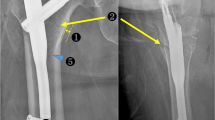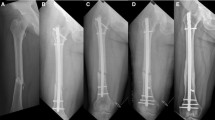Summary
Experimentally, two slotted nails, the Grosse-Kempf nail and the AO/ASIF universal femoral nail, were compared to the non-slotted Grosse-Kempf nail and control bone using a cadaver femoral osteotomy. The stiffnesses and strengths of the osteotomies fixed with slotted nails in 10–30° torsion were 6–8% and the values of non-slotted nails 40% of control bone. The maximal moments were 14–18% and 48%, respectively. In the “clinical range” of torsion, the implant-bone construct never failed or was deformed. Clinically, 46 femoral shaft fractures were randomized to treatment with Grosse-Kempf nails, 24 with slotted nails and 22 with non-slotted nails. Four complications in the slotted nail group and three in the non-slotted nail group were considered to be independent of the choice of nail and did not affect the end result. Three splinterings of the distal fragment, one resulting in a change of the osteosynthesis implant to a condylar plate, were considered to result from the high stiffness of the non-slotted nail. Osteosynthesis of femoral shaft fractures using slotted nails has not resulted in healing disturbances, which could be accounted for by the high torsional elasticity of the nail; there seems to be no indication for high-stiffness nails in femoral fractures.
Similar content being viewed by others
References
Alho A, Husby T, Rönningen H, Skjeldal S, Bugge W (1988) Biomechanical studies of three locked nails. Acta Orthop Scand 59:108
Babin SR, Graf P, Vidal P, Sur N, Schvingt E (1983) Le risque de non-consolidation après enclouage à foyer fermé et alésage. Resultats de 1059 interventions selon G. Kuntscher. Int Orthop 7:133–143
Beals N, Durham C, Lynch G (1988) Mechanical characterization of interlocking intramedullary nails. Material Research Report, Richards Medical Company, Memphis, Tenn
Chen W-F, Atsuta F (1977) Theory of beam-columns, vol 2: Space behavior and design. McGraw-Hill, New York
Decoulx J, Kempf I, Jenny G, Schvingt E, Petit P, Vives P (1975) Enclouage à foyer fermé avec alésage du fémur selon Kuntscher. Technique, indications et résultats. A propos de 399 cas. Res Chir Orthop 61:465–486
Frost HM (1976) An introduction to biomechanics. Thomas, Springfield, pp 393–394
Grosse A, Kempf I, Lafforgue D (1978) La traitement des fracas, pertes de substance osseuse et pseudarthroses du fémur et du tibia par l'enclouage vérrouillé (à propos de 40 cas). Rev Chir Orthop 64 [Suppl II]:33–45
Husby T, Höiseth A, Alho A, Rönningen H (1989) Rotational strength of the femoral neck. Acta Orthop Scand 60:288–292
Kempf I, Karger R, Willinger R, Francois JM, Cornet A, Renault D, Bonnel F (1985) Locked intramedullary nailing — Improvement of mechanical properties. In: Perren SM, Schneider E (eds) Biomechanics: current interdisciplinary research. Nijhoff, Dordrecht, pp 487–492
Klemm K, Schellmann WD (1972) Dynamische und statische Verriegelung des Marknagels. Monatsschr Unfallheilkd 75:568–575
Küntscher G (1949) Die Marknagelung. Saenger, Berlin
Küntscher G (1968) Die Marknagelung des Trümmerbruches. Langenbecks Arch Klin Chir 322:1063–1069
Laurence M, Freeman AR, Swanson SAV (1969) Engineering considerations in the internal fixation of fractures of the tibial shaft. J Bone Joint Surg [Br] 51:754–768
Martens M, Frankel VH, Burstein AH (1972) Ultimate properties of intramedullary nails. Injury 4:18–24
Mölster AO (1985) Stability in fracture healing. An experimental study on intramedullary nailing of intact and osteotomized long bones in rats. Thesis. University of Bergen, Bergen, Norway
Onoue Y, Sunami Y, Fujiwara H, Sadakane T, Yasuda S (1979) Treatment of the femoral shaft fracture with a curved heat-treated COP clover-leaf nail. Int Orthop 3:203–210
Strømsøe K, Thoresen BO, Ekeland A, Follerås G, Alho A (1990) Die Erfahrungen mit der Verriegelungsnagelung am Femur. Eine retrospektive Analyse 99 operierter FemurschaftFrakturen. Chirurg 61:430–433
Thoresen BO, Alho A, Ekeland A, Strömsöe K, Follerås G, Haukebö A (1985) Interlocking intramedullary nailing in femoral shaft fractures. A report of forty-eight cases. J Bone Joint Surg [Am] 67:1313–1320
Vécsei V (1983) Grundlagen der Verriegelungsnagelung — Biomechanische Grundlagen. Hefte Unfallheilkd 161:24–30
Winquist RA, Hansen ST, Clawson DK (1984) Closed intramedullary nailing of femoral fractures. J Bone Joint Surg [Am] 66:529–539
Zimmerman KW, Klasen HJ (1983) Mechanical failure of intramedullary nails after fracture union. J Bone Joint Surg [Br] 65:274–275
Author information
Authors and Affiliations
Rights and permissions
About this article
Cite this article
Alho, A., Moen, O., Husby, T. et al. Slotted versus non-slotted locked intramedullary nailing for femoral shaft fractures. Arch Orthop Trauma Surg 111, 91–95 (1992). https://doi.org/10.1007/BF00443474
Issue Date:
DOI: https://doi.org/10.1007/BF00443474




